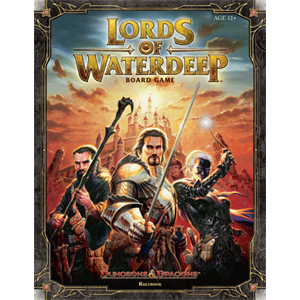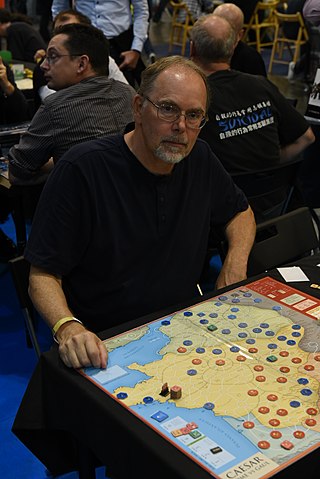
Here I Stand is a board wargame first published by GMT Games in 2006.

Here I Stand is a board wargame first published by GMT Games in 2006.
Here I Stand is a card-based wargame in which players struggle for religious and political influence over early 16th century Europe during the Reformation. It can be played by up to 6 players, who represent the Habsburg Empire, the Ottoman Empire, England, France, The Papacy, and The Protestants. The game begins in 1517 and ends in 1555, taking up to 9 turns to play each representing about 4 years of history.
The game is played in "impulses", with each player, one after the other, playing a single card during their impulse. Each card has a number on it indication the number of "command points" it grants the player, as well as text of a specific event, and generally players choose to either use the command points or to enact the event but not both. Command points are used to execute various military, political, religious, or exploratory actions such as moving armies or fleets, besieging a fortress, establishing overseas colonies, calling religious debates, or burning heretical books. The events on the cards represent either a specific historical detail (e.g. the Council of Trent), or a general occurrence such as the bribing of enemy mercenaries.
Victory is determined by the first player to exceed 25 Victory Points (VP), or the player with the most at the end of the game. VP are gained in a variety of ways which are slightly different for each of the 6 sides, but include things like controlling key cities or electorates, exploring the New World, the death or disgrace of opposing religious leaders, building castles or cathedrals, or successful piracy expeditions.
Here I Stand was first published by GMT Games in 2006, and was designed by Ed Beach, Matthew Beach, and Dave Cross.
A related sequel game, Virgin Queen (the title refers to Queen Elizabeth I), covering the second half of the 16th century, was published by GMT Games in 2012.
A 500th Anniversary Edition (commemorating Martin Luther's posting of his 95 Theses), featuring revised rules, new cards and other updates, was published in 2017. [1]
Uli Blennemann comments: "Here I Stand offers a ton of period flavor, and it is a game that tells you a story. What's more, it's better than a book or a movie. With just a little bit of imagination, you write a part of that story." [2]
Here I Stand won the 2006 Charles S. Roberts Award for Best Pre–World War II Boardgame. [3]
The game has been consistently ranked near or in the Top 10 of Boardgamegeek's War Game Rank since its release, peaking around 2011, although its ranking has been slowly declining over the years (#4 in 2011–2013, #5 in 2015, #7 in 2017, #8 in 2019, #9 in 2021). Likewise, its general rank has declined from around Top 50 in early 2010s to Top 250 in early 2020s. [4]

Steve Jackson Games (SJGames) is a game company, founded in 1980 by Steve Jackson, that creates and publishes role-playing, board, and card games, and the gaming magazine Pyramid.

Up Front is a World War II card-based wargame. It was designed by Courtney F. Allen and published by Avalon Hill in 1983. Hasbro now owns the franchise, and at one time licensed it to Multi-Man Publishing, a license that has since expired without republication of the game. There was an attempt to reprint Up Front through Kickstarter in 2013. The project raised over $300,000, but no updates to status has been posted since March 21, 2014.

Richthofen's War, subtitled "The Air War 1916–1918", is a board wargame published by Avalon Hill in 1973 that simulates aerial combat during World War I.

GMT Games is a California-based wargaming publisher founded in 1990. The company has become well known for graphically attractive games that range from "monster games", of many maps and counters, to quite simple games suitable for introducing new players to wargaming. They also produce card games and family games. The current management and creative team includes Tony Curtis, Rodger MacGowan, Mark Simonitch, and Andy Lewis.
Battle Cry is a board wargame based on the American Civil War, designed by Richard Borg and published by Avalon Hill in 2000.

Shogun is a strategy board game designed by Dirk Henn and published by Queen Games in 2006. It is based on his earlier game Wallenstein, but it is set in the Sengoku period, which ends with the inception of the Tokugawa Shogunate.
We the People is a board wargame about the American Revolution, published by Avalon Hill in 1993 and designed by Mark Herman. We the People was the first wargame to use cards as the primary way to control the pace and tempo of play, with a strong element of fog of war through the hidden card information. This started a new genre of wargames that have emphasized competitive play and a strong historical narrative.
BattleLore is a strategy board wargame for two players, created by Richard Borg and initially published by Days of Wonder in 2006. The game is based on the same mechanics as Battle Cry, Memoir '44 and Commands & Colors: Ancients, but has a fantasy and medieval theme.

Paths of Glory: The First World War, 1914–1918 is a strategy board wargame, designed in 1999 by the six-time Charles S. Roberts Awards winner Ted Raicer and published by GMT Games. It covers World War I from its outbreak to the 1918 Armistice, or based on the progress of the game a hypothetical later ending of the war in early 1919, possibly due to exhaustion of Europe. The game is played on a map of Europe and the Middle East as the game board.

Twilight Struggle: The Cold War, 1945–1989 is a board game for two players, published by GMT Games in 2005. Players are the United States and Soviet Union contesting each other's influence on the world map by using cards that correspond to historical events. The first game designed by Ananda Gupta and Jason Matthews, they intended it to be a quick-playing alternative to more complex card-driven wargames.

Enemy in Sight is a card game for 2–8 players published by Avalon Hill in 1988 that simulates naval warfare in the Age of Sail.

Commands & Colors: Ancients is a board wargame designed by Richard Borg, Pat Kurivial, and Roy Grider, and published by GMT Games in 2006. It is based on Borg's Commands & Colors system using some elements similar to his other games such as Commands & Colours: Napoleonics, The Great War, Memoir '44 and Battle Cry designed to simulate the "fog of war" and uncertainty encountered on real battlefields.

A board wargame is a wargame with a set playing surface or board, as opposed to being played on a computer or in a more free-form playing area as in miniatures games. The modern, commercial wargaming hobby developed in 1954 following the publication and commercial success of Tactics. The board wargaming hobby continues to enjoy a sizeable following, with a number of game publishers and gaming conventions dedicated to the hobby both in the English-speaking world and further afield.

Lords of Waterdeep is a German-style board game designed by Peter Lee and Rodney Thompson and published by Wizards of the Coast in 2012. The game is set in Waterdeep, a fictional city in the Forgotten Realms campaign setting for the Dungeons & Dragons role-playing game. Players take the roles of the masked rulers of Waterdeep, deploying agents and hiring adventurers to complete quests and increase their influence over the city.

Mark Simonitch is an American wargame designer and graphic artist. His game designs include Hannibal: Rome vs. Carthage and Ardennes '44, and he has made maps for Wilderness War and Empire of the Sun among others. He has worked at Avalon Hill and GMT Games. He was inducted into the Charles Roberts Awards Hall of Fame in 2002.
Ulrich Blennemann is a game designer who has worked primarily on board games.

Dominant Species is a 2010 competitive, area control board game published by GMT Games, designed by Chad Jensen. The game is an evolution-themed game in which players take on the role of broad categories of life: mammals, reptiles, birds, amphibians, arachnids, and insects in a world heading for the Ice Age.

Pax Pamir is a board game originally designed by Cole Wehrle and Phil Eklund, released in 2015 by Sierra Madre Games. Its second edition was solely designed by Wehrle and published in 2019 by Wehrlegig Games. It concerns the Russian, British, and Durrani empires struggling for dominance in Afghanistan, with players assuming the role of local leaders. Pax Pamir received positive reviews upon its release and was nominated for several awards.

Piercing the Reich, subtitled "The Battle for Aachen, Siegfreid Line Campaign, September–October 1944", is a board wargame published by Moments in History (MiH) in 1995 that is an operational simulation of the Battle of Aachen during World War II.
1989: Dawn of Freedom is a wargame designed by Jason Matthews and Ted Torgerson and published in 2012 by GMT Games. The game takes place in the final stages of the Cold War as two sides with opposing interests clash in the Eastern Bloc for power and control.